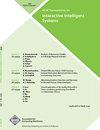Learning and Understanding User Interface Semantics from Heterogeneous Networks with Multimodal and Positional Attributes
IF 4.8
4区 计算机科学
Q2 COMPUTER SCIENCE, ARTIFICIAL INTELLIGENCE
引用次数: 1
Abstract
User interfaces (UI) of desktop, web, and mobile applications involve a hierarchy of objects (e.g., applications, screens, view class, and other types of design objects) with multimodal (e.g., textual and visual) and positional (e.g., spatial location, sequence order, and hierarchy level) attributes. We can therefore represent a set of application UIs as a heterogeneous network with multimodal and positional attributes. Such a network not only represents how users understand the visual layout of UIs but also influences how users would interact with applications through these UIs. To model the UI semantics well for different UI annotation, search, and evaluation tasks, this article proposes the novel Heterogeneous Attention-based Multimodal Positional (HAMP) graph neural network model. HAMP combines graph neural networks with the scaled dot-product attention used in transformers to learn the embeddings of heterogeneous nodes and associated multimodal and positional attributes in a unified manner. HAMP is evaluated with classification and regression tasks conducted on three distinct real-world datasets. Our experiments demonstrate that HAMP significantly out-performs other state-of-the-art models on such tasks. To further provide interpretations of the contribution of heterogeneous network information for understanding the relationships between the UI structure and prediction tasks, we propose Adaptive HAMP (AHAMP), which adaptively learns the importance of different edges linking different UI objects. Our experiments demonstrate AHAMP’s superior performance over HAMP on a number of tasks, and its ability to provide interpretations of the contribution of multimodal and positional attributes, as well as heterogeneous network information to different tasks.从具有多模态和位置属性的异构网络中学习和理解用户界面语义
桌面、web和移动应用程序的用户界面(UI)涉及具有多模态(例如,文本和视觉)和位置(例如,空间位置、序列顺序和层次级别)属性的对象层次(例如,应用程序、屏幕、视图类和其他类型的设计对象)。因此,我们可以将一组应用程序ui表示为具有多模态和位置属性的异构网络。这样的网络不仅表示用户如何理解ui的可视化布局,而且还影响用户如何通过这些ui与应用程序进行交互。为了更好地为不同的用户界面标注、搜索和评估任务建模,本文提出了一种基于异构注意的多模态位置(HAMP)图神经网络模型。HAMP将图神经网络与变压器中使用的尺度点积注意相结合,以统一的方式学习异构节点的嵌入以及相关的多模态和位置属性。HAMP通过对三个不同的真实世界数据集进行分类和回归任务来评估。我们的实验表明,HAMP在这类任务上的表现明显优于其他最先进的模型。为了进一步解释异构网络信息的贡献,以理解UI结构和预测任务之间的关系,我们提出了自适应HAMP (AHAMP),它自适应地学习连接不同UI对象的不同边的重要性。我们的实验证明了AHAMP在许多任务上优于HAMP,并且它能够提供对多模态和位置属性的贡献的解释,以及对不同任务的异构网络信息。
本文章由计算机程序翻译,如有差异,请以英文原文为准。
求助全文
约1分钟内获得全文
求助全文
来源期刊

ACM Transactions on Interactive Intelligent Systems
Computer Science-Human-Computer Interaction
CiteScore
7.80
自引率
2.90%
发文量
38
期刊介绍:
The ACM Transactions on Interactive Intelligent Systems (TiiS) publishes papers on research concerning the design, realization, or evaluation of interactive systems that incorporate some form of machine intelligence. TIIS articles come from a wide range of research areas and communities. An article can take any of several complementary views of interactive intelligent systems, focusing on:
the intelligent technology,
the interaction of users with the system, or
both aspects at once.
 求助内容:
求助内容: 应助结果提醒方式:
应助结果提醒方式:


